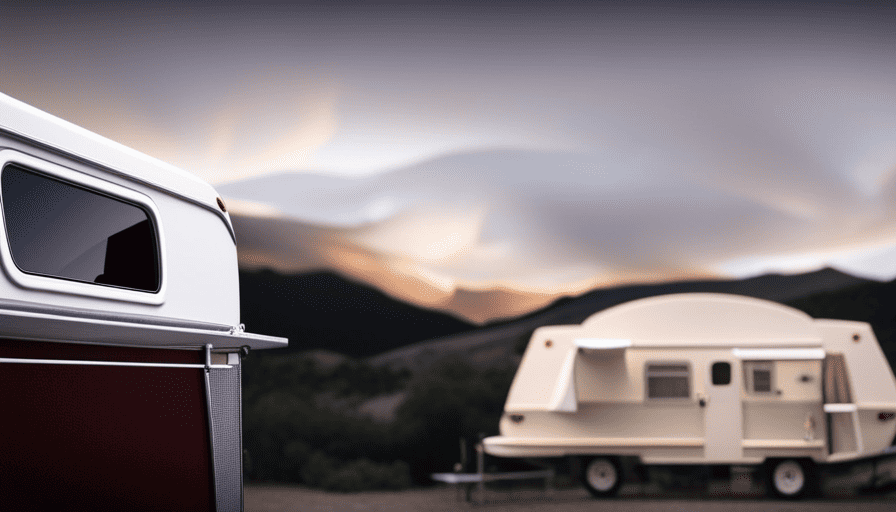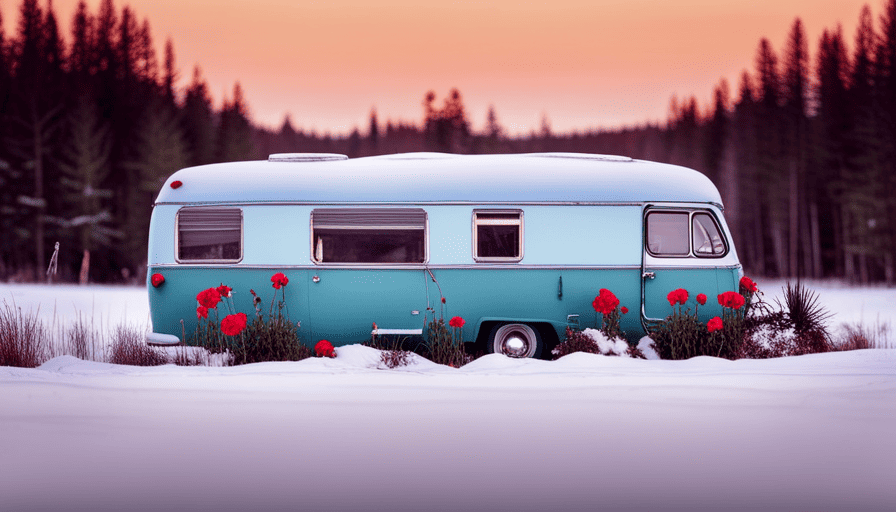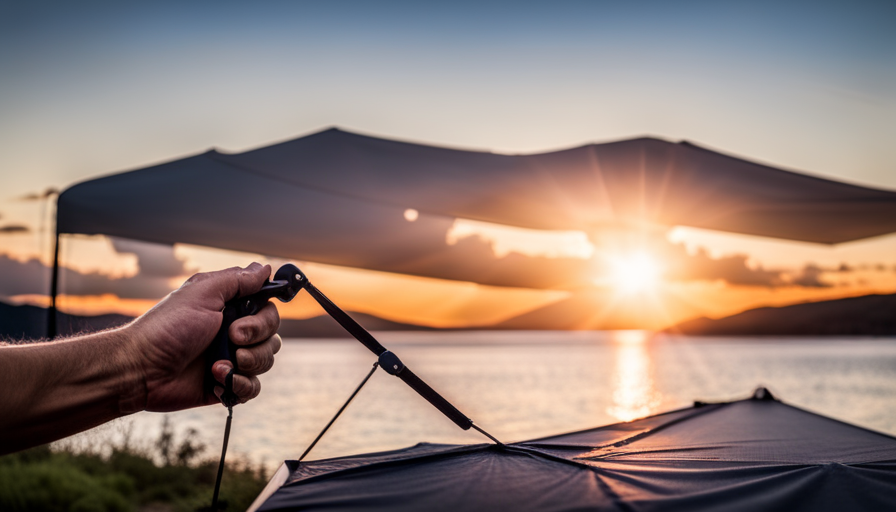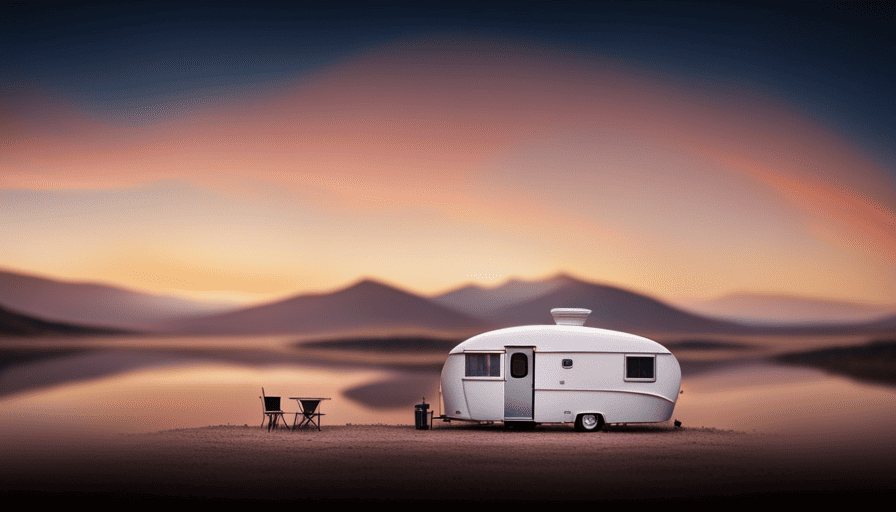Picture yourself starting a journey where your home is constantly by your side, effortlessly fitting into the bed of your reliable pickup truck. It serves as a movable sanctuary, a comfortable refuge on wheels that travels with you to the most picturesque locations.
Building your own slide-in camper allows you to create a space tailored to your unique needs, ensuring comfort and convenience wherever you roam. In this comprehensive guide, I will walk you through the step-by-step process of constructing your very own slide-in camper. From determining the perfect size and layout to installing windows and appliances, no detail will be left untouched. Additionally, we will cover important topics such as insulation, electrical wiring, and leveling a camper to ensure that every aspect of your DIY project is thoughtfully executed. Whether you’re an experienced builder or a first-time DIY-er, this guide will equip you with the knowledge and confidence to create the perfect slide-in camper for your next adventure. With the right tools and a bit of patience, you’ll soon be hitting the open road in a camper that’s truly your own. Furthermore, we will delve into the important task of how to level a camper on blocks, providing you with the essential knowledge and techniques to ensure a stable and safe living environment. You’ll learn the proper methods for using leveling blocks and stabilizing jacks, as well as tips for finding the most level spot at your campsite. By mastering these skills, you’ll be able to enjoy a comfortable night’s sleep no matter where your travels take you. Whether you’re parked on uneven terrain or at a slight angle, you’ll have the expertise to quickly and effectively level your camper for a stress-free camping experience.
So grab your tools and let’s dive into the world of DIY camper building. Together, we will transform a simple truck bed into a home away from home, ready to hit the open road and create unforgettable memories.
Key Takeaways
- Choose durable and long-lasting materials for construction.
- Maximize space and incorporate clever storage solutions.
- Consider electrical and plumbing considerations.
- Pay attention to insulation, finishing, and furniture/storage solutions.
Determine Your Camper’s Size and Layout
Get ready to design the ultimate home on wheels that’ll make your heart race with excitement as you decide on the perfect size and layout for your slide-in camper!
When determining your camper’s size and layout, it’s crucial to consider a few key factors. First and foremost, think about the materials you want to use for your camper. Choosing the right materials is essential for durability and longevity. Opt for lightweight yet sturdy materials that can withstand the wear and tear of the road.
Additionally, consider maximizing space in your camper’s layout. Think about how you’ll be using the space and plan accordingly. Incorporate clever storage solutions, such as hidden compartments and foldable furniture, to make the most of every inch.
When you’ve finalized your camper’s size and layout, it’s time to gather the necessary materials and tools. From wood and metal to screws and hinges, make sure you have everything you need to bring your design to life.
With your materials in hand, you can now move on to the next step of building your dream slide-in camper.
Gather the Necessary Materials and Tools
To successfully construct your slide-in camper, you’ll need to assemble the required materials and gather the essential tools. Choosing the right materials is crucial for the durability and functionality of your camper. Look for lightweight yet sturdy materials that can withstand various weather conditions. Some common materials include plywood, fiberglass, aluminum, and foam insulation.
Additionally, you’ll need screws, bolts, adhesive, sealant, and other fasteners to secure everything in place.
Finding the necessary tools is equally important. Here are three essential tools you’ll need:
- Power tools: Invest in a good quality drill, jigsaw, and circular saw to make precise cuts and holes in the materials.
- Measuring tools: A tape measure, level, and square will help ensure accurate measurements and angles.
- Safety equipment: Don’t forget to wear safety goggles, gloves, and a dust mask to protect yourself during construction.
With all the materials and tools ready, you can now move on to the next step and design the camper’s floor plan and interior features. This will involve determining the layout of the sleeping area, kitchenette, storage compartments, and any other desired features. By carefully planning and considering your needs, you can create a functional and comfortable living space in your slide-in camper.
Design the Camper’s Floor Plan and Interior Features
Once you’ve gathered all the necessary materials and tools, it’s time to envision and create the perfect layout and interior features for your home on wheels. Designing the camper’s floor plan and interior is an exciting step in building a slide-in camper.
To make the most of the limited space available, it’s important to consider camper decor ideas that maximize space and functionality. Start by sketching out the floor plan on graph paper, taking into account the dimensions of your camper and the specific features you want to include. Consider the placement of essential elements such as the bed, kitchenette, seating area, and storage. Think about how to optimize storage solutions, such as utilizing under-bed compartments and overhead cabinets.
When designing the interior, think about the overall aesthetic you want to achieve. Choose colors, materials, and patterns that create a cozy and inviting atmosphere. Consider using lightweight and durable materials that are easy to clean and maintain.
Incorporate space-saving features such as foldable furniture, built-in storage units, and multi-purpose items. Think creatively to maximize every inch of available space.
With the floor plan and interior design in mind, it’s time to move on to the next step: constructing the camper’s frame and walls. By carefully planning and designing the layout and interior features, you’ll be one step closer to creating your dream home on wheels.
Construct the Camper’s Frame and Walls
Start constructing your camper’s frame and walls, bringing your dream home on wheels to life.
The camper frame construction is a critical step in ensuring the structural integrity of your camper. Begin by measuring and cutting the metal or wooden beams according to your floor plan. Use a level to ensure that the frame is square and level before securing it together with screws or bolts. Reinforce the corners with metal brackets for added stability.
Next, it’s time to assemble the walls. Start by cutting the plywood or composite panels to the desired height and width. Attach them to the frame using nails or screws, making sure to leave space for windows and doors. To enhance insulation, consider adding foam insulation panels between the frame and walls.
Once the walls are securely in place, it’s time to install windows, doors, and roofing. This step will not only provide natural light and ventilation but also protect your camper from the elements.
Transitioning into the next section, let’s focus on how to install windows, doors, and roofing to complete the exterior of your slide-in camper.
Install Windows, Doors, and Roofing
Now, it’s time for you to bring light, fresh air, and protection from the elements to your dream home on wheels by installing windows, doors, and roofing. This step is crucial in creating a comfortable and functional living space inside your slide-in camper.
Here’s what you need to do:
-
Start by installing insulation around the window and door openings. This will help regulate temperature and reduce noise inside the camper. Use a high-quality insulation material and ensure a tight seal to maximize efficiency.
-
Choose window types that suit your needs. Consider factors such as size, ventilation options, and durability. Common options include sliding windows, awning windows, and fixed windows. Install them securely, ensuring they’re watertight and properly sealed.
-
Install the doors next. Opt for sturdy, weather-resistant doors that provide security and insulation. Ensure a proper fit and install weatherstripping to prevent drafts and water leaks.
-
Finally, install the roofing. Choose a roofing material that’s lightweight, durable, and weatherproof. Popular options include aluminum, fiberglass, and rubber. Securely attach the roofing, ensuring there are no gaps or areas prone to leaks.
Now that your camper is equipped with windows, doors, and roofing, it’s time to move on to the next step: wiring the camper for electricity and installing plumbing. This’ll provide you with the necessary utilities to fully enjoy your mobile living space.
Wire the Camper for Electricity and Install Plumbing
To truly embrace the nomadic lifestyle, let the currents of electricity flow through your mobile sanctuary and let the plumbing quench your thirst for adventure. When it comes to wiring the camper for electricity, you have two options: traditional electricity or solar power. Traditional electricity requires connecting your camper to a power source at a campsite or using a generator. On the other hand, solar power harnesses the energy of the sun to power your camper, giving you the freedom to roam without relying on external power sources.
For a practical and detail-oriented approach, let’s compare the two options in a table:
| Electricity | Solar Power |
|---|---|
| Requires external power source or generator | Harnesses the sun’s energy |
| Can be expensive to set up and maintain | Initial investment, but no ongoing costs |
| More reliable in all weather conditions | Dependent on sunlight availability |
Now, let’s talk about plumbing. You have the choice between installing a traditional plumbing system or opting for a composting toilet. Traditional plumbing allows you to have running water for showers, sinks, and toilets, but it requires access to water sources and a sewage system. On the other hand, a composting toilet is a more eco-friendly option that turns waste into compost. It doesn’t require water or a sewage system, making it ideal for off-grid adventures.
In the next section on how to build a slide-in camper, we will discuss how to insulate and finish the interior walls and ceiling, creating a cozy and comfortable living space.
Insulate and Finish the Interior Walls and Ceiling
Get ready to transform your mobile sanctuary into a cozy, comfortable haven by insulating and finishing the interior walls and ceiling. Insulating techniques are crucial to ensure that your slide-in camper is well-insulated, providing you with warmth during cold nights and keeping the interior cool in hot weather.
One effective technique is to use spray foam insulation, which expands to fill any gaps or crevices, creating a seamless barrier against outside temperatures. Additionally, you can install insulation panels made of materials such as foam board or fiberglass, which offer excellent thermal properties.
Once the insulation is in place, it’s time to finish the walls and ceiling. There are various finishing materials you can choose from, depending on your preferences and budget. Wood paneling is a popular choice for its natural and rustic appeal, while vinyl and laminate offer durability and easy maintenance. You can also consider using wallpaper or fabric to add a touch of personality to your interior.
As you finish the walls and ceiling, remember to pay attention to details such as trim and molding to achieve a polished look. These finishing touches can enhance the overall aesthetics of your camper.
With the interior walls and ceiling insulated and finished, you can now move on to the next section about building and installing furniture and storage solutions seamlessly.
Build and Install Furniture and Storage Solutions
After insulating and finishing the interior walls and ceiling of my slide-in camper, it’s time to move on to the next step: building and installing furniture and storage solutions. This is where the true transformation of the space begins, as I carefully plan the layout and placement of each piece to maximize functionality and comfort.
To start, I’ll create a detailed floor plan, taking into consideration the dimensions of the camper and my specific needs. This will help me determine the best locations for key furniture items such as the bed, table, and seating area.
Next, I’ll begin constructing the furniture using lightweight yet sturdy materials like plywood or composite panels. I’ll make sure to measure twice and cut once to ensure everything fits perfectly into the limited space. To optimize storage organization, I’ll incorporate clever solutions such as built-in cabinets with adjustable shelves, under-bed storage compartments, and overhead compartments.
Once the furniture is built, I’ll securely install it in the designated areas, making sure everything is level and stable. This will involve anchoring the pieces to the walls or floor, using appropriate hardware for a secure fit.
With the furniture and storage solutions in place, my slide-in camper will start to resemble a cozy and functional living space. In the next section, I’ll delve into the exciting process of installing appliances and fixtures, bringing even more convenience and comfort to my mobile home away from home.
Install Appliances and Fixtures
Now it’s time to bring even more convenience and comfort to your mobile home away from home by installing appliances and fixtures. When it comes to RV appliances, it’s important to choose ones that are specifically designed for mobile use. This ensures that they’re compact, energy-efficient, and can withstand the vibrations and movements of the road.
Refrigerators, stoves, and ovens are essential appliances that can make your camping experience more enjoyable. Additionally, consider installing a microwave for quick and easy meals on the go.
Next, let’s talk about plumbing fixtures. Installing a water heater will provide you with hot water for showers and dishwashing. Look for models that are specifically designed for RVs to ensure compatibility and proper installation. To make your camper feel more like home, consider installing a bathroom with a toilet and shower. There are compact and lightweight options available that can fit seamlessly into your slide-in camper.
As you install the appliances and fixtures, make sure to follow the manufacturer’s instructions carefully to ensure proper functionality and safety. Once everything’s installed, it’s time to test and fine-tune your slide-in camper to make sure everything’s working smoothly.
Test and Fine-Tune Your Slide-In Camper
Once all the appliances and fixtures are in place, it’s time to ensure that your mobile home away from home is in perfect working order. Testing and fine-tuning your slide-in camper is crucial for a smooth and hassle-free camping experience. Here are some steps to follow for slide-in camper maintenance and troubleshooting common camper issues:
-
Electrical System:
- Check all electrical connections and make sure they’re secure.
- Test all lights, including interior and exterior lights, to make sure they’re functioning properly.
-
Plumbing System:
- Inspect all water lines and connections for any leaks or damage.
- Run water through all faucets and check for proper water flow and drainage.
-
Gas System:
- Test the gas lines and connections for leaks using a gas leak detector.
- Make sure the stove, oven, and refrigerator are all functioning correctly.
-
Slide-Out Mechanism:
- Extend and retract the slide-out multiple times to ensure smooth operation.
- Lubricate the slide-out mechanism as per the manufacturer’s recommendations.
-
General Maintenance:
- Inspect the exterior for any signs of damage, such as cracks or leaks.
- Check the tires for proper inflation and tread wear.
By following these maintenance steps and troubleshooting any common camper issues, you can have peace of mind knowing that your slide-in camper is in optimal condition for your next adventure.
Frequently Asked Questions
How do I secure the slide-in camper to my truck bed?
To secure a slide-in camper to a truck bed, you’ll need reliable truck bed security and camper tie downs. Start by installing a set of sturdy camper tie downs that attach to the truck bed. These tie downs should be specifically designed for slide-in campers and provide a secure connection.
Once the tie downs are in place, use them to fasten the camper tightly to the truck bed, ensuring a safe and stable attachment.
What permits or regulations do I need to be aware of when building a slide-in camper?
When it comes to building a slide-in camper, it’s important to be aware of the permit requirements and legal dimensions. Before starting the construction process, I recommend checking with your local authorities to understand any permits or regulations that may apply.
This will ensure that you’re in compliance with the law and can avoid any potential issues. Additionally, familiarize yourself with the legal dimensions for slide-in campers to ensure that your build meets the necessary size restrictions.
How do I properly seal the windows, doors, and roof to ensure no leaks?
To properly seal the windows, doors, and roof and prevent any leaks, it’s crucial to focus on proper window installation. I learned this the hard way when I built my slide-in camper. By following the manufacturer’s instructions and using high-quality sealants and adhesives, I was able to ensure a watertight seal.
Additionally, it’s important to consider ventilation to prevent condensation buildup, which can lead to mold and mildew.
What are the best options for heating and cooling in a slide-in camper?
The best heating options for a slide-in camper include propane heaters, electric heaters, and diesel heaters. Propane heaters are commonly used and provide efficient heat, while electric heaters are convenient if you have access to electricity. Diesel heaters are a popular choice for those who want a reliable and fuel-efficient heating option.
For cooling, options include rooftop air conditioners, portable air conditioners, and vent fans. Rooftop air conditioners are the most common and effective option for cooling the interior of a slide-in camper.
Are there any safety considerations I should keep in mind when using a slide-in camper, such as weight distribution or towing capacity?
When using a slide-in camper, it’s crucial to consider safety factors like weight distribution and towing capacity.
Some may argue that these considerations can be overwhelming and limit the options available. However, prioritizing weight distribution ensures stability while towing, preventing accidents and damage.
Additionally, adhering to the manufacturer’s recommended towing capacity ensures a safer and more enjoyable camping experience.
So, while it may seem like a hassle, these safety measures are essential for your well-being and peace of mind.
Can I Use the Same Techniques to Build a Slide Out on a Camper as I Would for a Slide In Camper?
Yes, the techniques for building a camper slide-out are similar whether you are creating a slide-out for a slide-in camper or a slide-out on a camper itself. From measurements and reinforcements to framing and weatherproofing, the process follows a similar structure. The only difference lies in adapting the design to fit the specific type of camper.
Conclusion
After countless hours of measuring, sawing, and hammering, my slide-in camper’s walls stand tall and sturdy, protecting me from the elements. The windows and doors are like portals to adventure, allowing me to soak in the breathtaking views.
Inside, the insulation wraps around like a warm embrace, keeping me cozy on chilly nights. The furniture and storage solutions fit like puzzle pieces, maximizing every inch of space. And with the appliances and fixtures in place, this camper’s ready for any journey that lies ahead.











